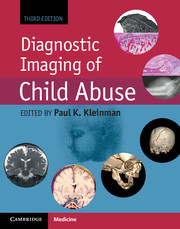Book contents
- Frontmatter
- Dedication
- Contents
- List of Contributors
- Editor’s note on the Foreword to the third edition
- Foreword to the third edition
- Foreword to the second edition
- Foreword to the first edition
- Preface
- Acknowledgments
- List of acronyms
- Introduction
- Section I Skeletal trauma
- Section II Abusive head and spinal trauma
- Chapter 16 Abusive head trauma: clinical, biomechanical, and imaging considerations
- Chapter 17 Abusive head trauma: scalp, subscalp, and cranium
- Chapter 18 Abusive head trauma: extra-axial hemorrhage and nonhemic collections
- Chapter 19 Abusive head trauma: parenchymal injury
- Chapter 20 Abusive head trauma: intracranial imaging strategies
- Chapter 21 Abusive craniocervical junction and spinal trauma
- Section III Visceral trauma and miscellaneous abuse and neglect
- Section IV Diagnostic imaging of abuse in societal context
- Section V Technical considerations and dosimetry
- Index
- References
Chapter 18 - Abusive head trauma: extra-axial hemorrhage and nonhemic collections
from Section II - Abusive head and spinal trauma
Published online by Cambridge University Press: 05 September 2015
- Frontmatter
- Dedication
- Contents
- List of Contributors
- Editor’s note on the Foreword to the third edition
- Foreword to the third edition
- Foreword to the second edition
- Foreword to the first edition
- Preface
- Acknowledgments
- List of acronyms
- Introduction
- Section I Skeletal trauma
- Section II Abusive head and spinal trauma
- Chapter 16 Abusive head trauma: clinical, biomechanical, and imaging considerations
- Chapter 17 Abusive head trauma: scalp, subscalp, and cranium
- Chapter 18 Abusive head trauma: extra-axial hemorrhage and nonhemic collections
- Chapter 19 Abusive head trauma: parenchymal injury
- Chapter 20 Abusive head trauma: intracranial imaging strategies
- Chapter 21 Abusive craniocervical junction and spinal trauma
- Section III Visceral trauma and miscellaneous abuse and neglect
- Section IV Diagnostic imaging of abuse in societal context
- Section V Technical considerations and dosimetry
- Index
- References
Summary
Introduction
The radiologist plays a pivotal role in the comprehensive medical assessment of the infant and child suspected of being a victim of inflicted injury. Keen observation of those intracranial manifestations that are strongly suggestive of abusive head trauma (AHT), and the clear communication of these findings to Child Protective Services (CPS) promote accurate diagnosis and early treatment, and influences forensic investigations. This chapter begins with a thorough review of the cranial meninges. A detailed discussion of the origin and the imaging features of hemorrhage in and adjacent to these brain coverings follows. Causal mechanisms of hemorrhage including AHT, accidental head trauma (AccT), and nontraumatic causes as well as mimics of subdural hemorrhage (SDH) are explored.
The cranial meninges
An understanding of the cranial meninges, and particularly the relationship of the arachnoid and dura mater, remain fundamental to the observations and insights made by the radiologist who is responsible for the interpretation of pediatric cross-sectional brain imaging, including the patterns of intracranial injury (ICI) seen in the setting of pediatric AHT and AccT (1–3).
Meninges, means membrane in Greek and was first used in the third century BC by Erasistus to describe the membranous covering of the central nervous system (CNS). In the same century, Herophilus introduced the term arachnoid (spiderlike) to describe his observations of the subarachnoid space (SAS) trabeculae. Previously, Galen had described two meningeal layers; the pacheia and the lepte. Hali Abbas provided Arabic translations of terms describing the meninges including Umm al-dimagh (mother of the brain) that was further subdivided into Umm al-ghalida (hard mother) and Umm al-raqiqah (thin mother). In the twelfth century, the Italian monk Stephen of Antioch translated the Arabic terms into the Latin that is more familiar to medical practitioners today; the dura (hard) mater and the pia (pious) mater (4).
- Type
- Chapter
- Information
- Diagnostic Imaging of Child Abuse , pp. 394 - 452Publisher: Cambridge University PressPrint publication year: 2015
References
- 13
- Cited by

